The iPhone 7 and iPhone 7 Plus Review: Iterating on a Flagship
by Joshua Ho & Brandon Chester on October 10, 2016 8:00 AM EST- Posted in
- Smartphones
- Apple
- Mobile
- iOS
- iOS 10
- iPhone 7
- iPhone 7 Plus
Battery Life
As-is, one of the most important factors for upgrading a smartphone remains battery life, due to a combination of inherent demand for a phone that can last 2-3 days of use and applications that demand enormous amounts of performance over long periods of time. Apps like WeChat are fairly notorious for holding wakelocks on Android and never really stopping background resource usage so there’s also an element of OS optimization that goes with keeping real-world in battery life up to expectations.
In order to test these things, we’ve spent the past year developing and validating a new web browsing battery life test which updates the sites used and introduces a scrolling component which attempts to better model how a number of tasks are not simply race to sleep and contain a steady-state component. We’ve also updated our rundown tests to better reflect reality and maintain appropriate loads as some devices with high-end SoCs and low display resolution were outpacing our testing. As always, all displays are set to 200 nits with location and other background services disabled to reach a useful relative comparison.

Looking at our WiFi web browsing test, it’s genuinely ridiculous how well the iPhone 7 and 7 Plus perform in this test. The iPhone 7 Plus is definitely down on battery life compared to the Galaxy S7 Edge, but it’s within 5% despite using a battery that’s almost 20% smaller. The iPhone 7 is actually comparable in battery life to the iPhone 7 Plus, and is significantly above the Galaxy S7 with Exynos 8890. Of course, the iPhone 7 has a significantly lower resolution display and a smaller battery, but the nature of smartphone design is that larger devices will generally have better battery life because the board area needed remains mostly constant while the amount of area for battery increases. The iPhone 7 has significantly improved in battery life here, likely due to a combination of A10 Fusion's power optimizations – particularly the small CPU cores – and the removal of the headphone jack, which teardown photos show to have been partially replaced with the battery. However if you do the math efficiency sees a relatively minor uplift.
One other interesting point is that Brandon accidentally ran the battery test on his iPhone 7 with a Safari Content Blocker enabled, which blocked all the ads on the sites that the test visits. In doing so, battery life rose from the normal result of 9.22 hours to 10.03 hours, demonstrating how the increased workload and long-running network requests from ads and trackers really impacts a smartphone's battery life. It's also worth noting that our test constantly cycles through pages, so if you spend a lot of time on a single page with ads you could see an even greater difference.
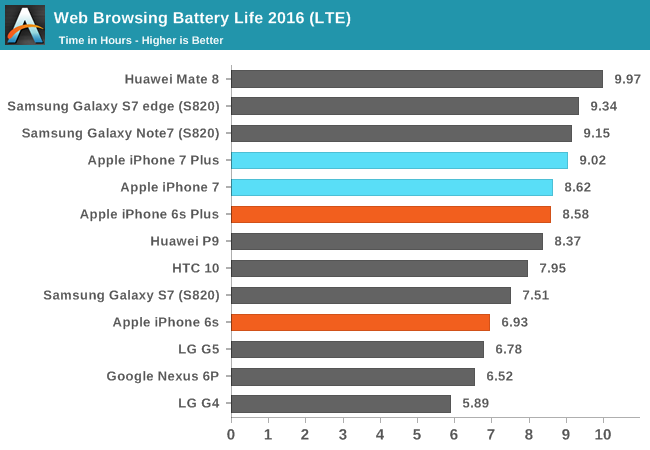
Moving on to LTE battery life the iPhone 7 and 7 Plus both slip a bit, but remain impressive. I suspect that the 20nm Qualcomm modem here is not well-equipped to handle the endless stream of ads that is increasingly a part of most websites. As ads tend to stream in incredibly slowly, the standby power of the modem is a significant factor. Snapdragon 820 devices don’t see nearly the impact here that the iPhone 7 and 7 Plus as their modem is on 14LPP rather than 20SoC. The iPhone 7 remains above the S820 Galaxy S7, but the iPhone 7 Plus is fairly comparable to the iPhone 6s Plus in battery life on LTE.

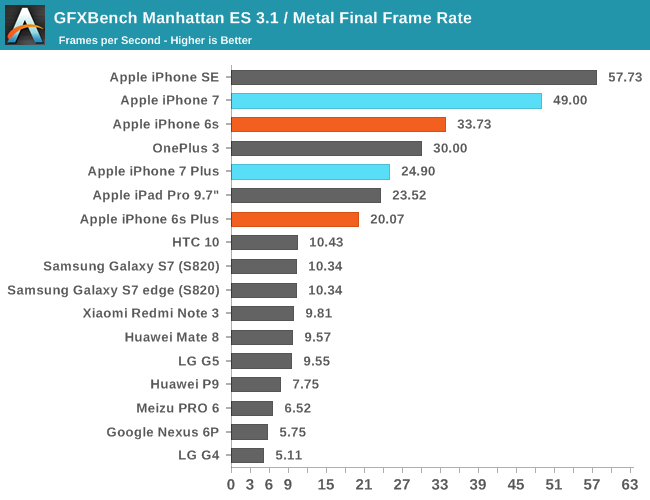
Moving past the web browsing test we use we can take a look at how the iPhone 7 Plus throttles. Unfortunately Basemark OS II was basically broken in this regard for the CPU rundown test so we can only look at how it behaves on Manhattan 3.1, but it's interesting to see how the GPU performance drops about 40% for the iPhone 7 Plus while the iPhone 7 throttles around 20%, because even Manhattan 3.1 is pegged to vsync which means that the GPU can spend much more time idling once a given frame is rendered. It's probably not a surprise here but the iPhone 7 just doesn't last very long here because battery life is strongly SoC-bound. If you attempted to plot battery life as a function of overall SoC utilization, it's entirely possible that the iPhone 7 might last longer than the 7 Plus at the lower bound for utilization, but as soon as you go past web browsing and similarly "light" tasks the 7 Plus and most phablets are going to strongly outperform such a small phone. Here the larger battery helps to get the iPhone 7 Plus nearly another hour of battery life when the SoC is under full, continuous load.
Charge Time
As usual, while battery life is the salient characteristic that determines overall mobility, it’s important to not ignore charge time as there are a number of edge cases where charging has a significant impact on overall mobility. In order to test this we use power measurements at the wall and measure the time it takes from the moment that the charger is plugged in to the moment that it falls below a pre-determined draw from the wall. While this isn’t perfect due to varying levels of DC conversion efficiency and different methods of trickle charging, this method provides at least a reasonable approximation of how long it will take to charge a device.
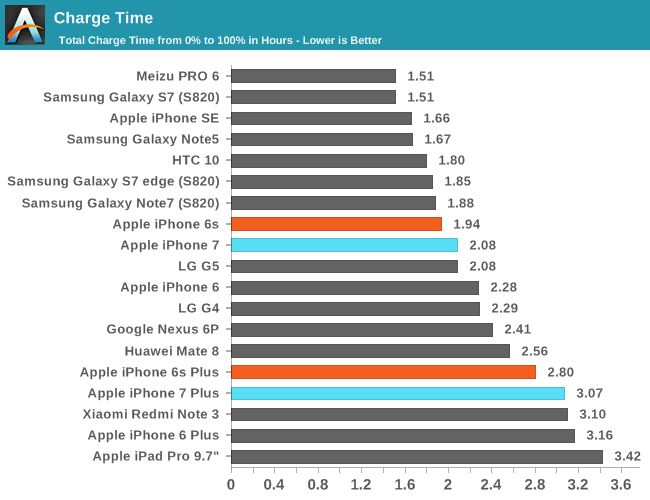
In the case of the iPhone 7 and 7 Plus, Apple continues to ship their standard 5W chargers for US variants. Looking at the results, it’s probably obvious that at least in the case of the iPhone 7 Plus, there is a very real need for Apple to start shipping something with faster charging, as the standard 5W charger takes a full hour longer than most of its competition to charge to 100%. Even the iPhone 7 could use a higher power charger here as using the device while it is charging will significantly impact the charging rate as the charger cannot supply enough power to the board while also charging the battery. And in the case of both phones, the lack of a high power charger doesn't just draw out the total charge time, but it also precludes rapid charging (partially charging a depleted phone very quickly) as well.
It would really be prudent for Apple to start to transitioning to higher power AC adapters at this point. This doesn’t take away from how impressive battery life is, but overall mobility isn’t going to be better than the competition unless you go out of your way to buy an iPad charger.


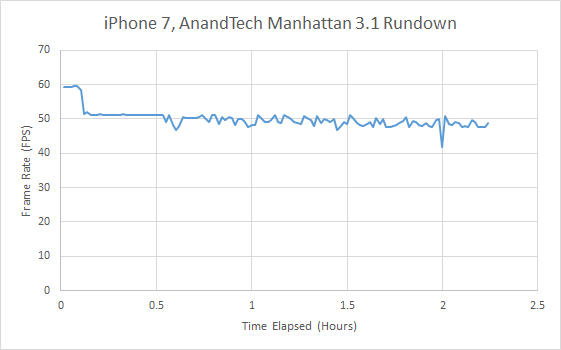
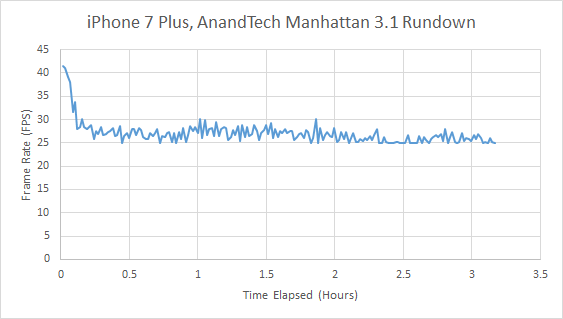
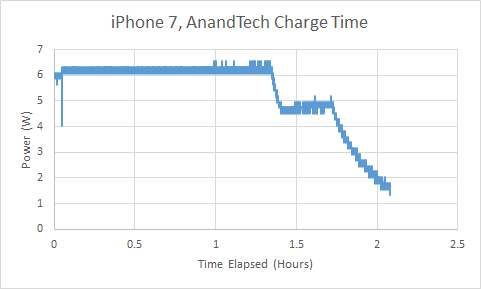
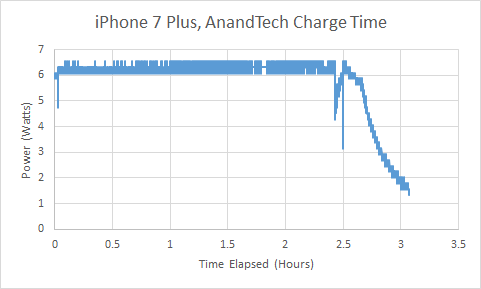








377 Comments
View All Comments
ws3 - Tuesday, October 11, 2016 - link
I have an iPhone 6 and I use headphones often. I would say that I have wanted to listen while charging maybe 2-3% of the times I have used headphones.It does happen, and it would be annoying those 2-3% of the times, but it's not common enough to be a deal breaker for me.
Generally I use the headphones in the night and at the end of the day I almost always have around 30% battery on my phone which is good for 3+ hours of headphone use.
MadaMadaDesu - Wednesday, October 19, 2016 - link
Well then stop buying phones with crappy battery life.Ryan Smith - Tuesday, October 11, 2016 - link
Unfortunately that review was a bit of a one-off. The equipment used there is not something we have access to, so we can't replicate the tests. But it's definitely something we'd like to do if we had the opportunity.zeeBomb - Monday, October 10, 2016 - link
Great review as always, and awesome footnotes between the differences in iOS and Android for optimization and performance.Hey, what do you guys mean when the iPhone is lacking in z-height? As in the top of where the iPhone sits on the top right corner or the portion where the lens stick out? The protrusion?
Constructor - Monday, October 17, 2016 - link
It's not thick enough to support a longer focus and thus a larger lens, leading to less light on the sensor through the small lens and more noise in low-light situations.fanofanand - Monday, October 10, 2016 - link
I thought this was an excellent review, and the first review of any Apple product in a LONG time that didn't read like the author was angling for a job in Cupertino. The phone itself looks amazing (I will never buy an Apple product period, but let's be honest shall we?) and it sets a high bar for Android to compete against. It will be interesting to see what they come up with next year, because it looks like all they did this year was turn up clock speeds. They won't be able to do that again next year.syxbit - Monday, October 10, 2016 - link
"The latest generation of Android devices outpaced Apple's A9 SoC some time ago, so that's one area where Apple could stand to improve against the competition."Wow AnandTech has gone down hill. How can you make a statement like that without data. In what way has the A9 been outpaced? There are many things in the iPhone that could stand to improve, but the SoC is not one of them.
Brandon Chester - Monday, October 10, 2016 - link
That statement was missing the specification of GPU performance, which is an area where 2016's Android devices did move past A9. I have amended the statement, and I apologize for the error, but I see no basis for jumping to the conclusion that "AnandTech has gone down hill" because two words were missing from a sentence.RT81 - Monday, October 10, 2016 - link
I use a Mac and an iPhone for my music production projects, so I enjoy the reviews on Apple stuff. However, you all have to admit, the Anandtech comment crowd isn't really the target audience for this stuff. These are people that grew up hating Apple because the only thing they really care about is benchmarks and raw power for gaming and they hold a grudge against Apple for marketing themselves as being the cool, trendy company.Paying more for a computer that is basically an appliance with a warranty is meaningless when all you care about is tinkering and min-maxing hardware for performance.
As long as you guys continue to review Apple products, you all are going to have thicker skin.
RT81 - Monday, October 10, 2016 - link
*going to NEED to have thicker skin